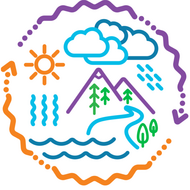
(View Complete Item Description)
The “Systems Are Everywhere” module was originally written for high school science teachers or counselors to use in any setting (in class or in extracurricular programs). However, during field-testing, we found that many elementary and middle school teachers were able to use these lessons successfully with their students. The module is made up of three lessons that serve to foster students’ understanding of systems, systems models, and systems thinking at every level of learning and across many content areas. Blended throughout the lessons are career connections that will introduce students to diverse systems thinkers in STEM, and provide context for how systems approaches are used in real life to address complex problems. The lessons and module can be used as a stand-alone set of activities or can be integrated into any course as an extension or enrichment.
The module begins with students modeling a complex system. Students will brainstorm and sketch the parts and connections of the system, then use an online tool (Loopy) to model the interactions of those parts and connections. Next, students will develop their understanding of systems thinking skills and their application for addressing problems and solutions. Then, students will apply their knowledge and skills to model a system of their choosing. Lastly, they will showcase their skills by creating a student profile and integrating their systems thinking skills into a resume.
Target Audience
This is our introductory module that we recommend teaching before each of our other modules to give students a background in systems and to help them understand the many careers available in STEM. This module can be applied easily to any content area and works best as written for students between 6th and 12th grades but can be adapted for other ages. It works very well when teaching virtually and in-person. If you are looking for an introduction to systems that can be delivered in-person with more kinesthetic activities, please see our Introduction to Systems module. The Intro to Systems module works best with 8-12 grade students, though can be used with some modifications for 6-7th graders. This Systems are Everywhere module can work well for elementary through secondary grades.
Material Type:
Activity/Lab,
Assessment,
Homework/Assignment,
Lesson,
Lesson Plan,
Module,
Student Guide,
Teaching/Learning Strategy,
Unit of Study
Authors:
Abigail Randall,
Baliga Lab,
Barbara Steffens,
Claudia Ludwig,
Eric Muhs,
Institute for Systems Biology,
Jennifer Eklund,
Linnea Stavney,
Michael Walker,
Rachel Calder,
Rebecca A. Howsmon,
Stephanie Swegle,
Systems Education Experiences,
Yuna Shin



















